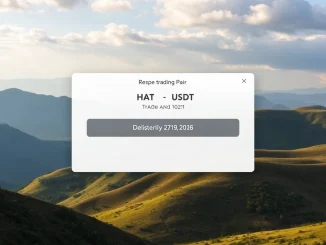
Big news from Cupertino! Apple has made significant updates to its iOS App Store guidelines, particularly impacting developers working with cryptocurrency and NFTs. For years, the tech giant maintained a cautious, often restrictive, stance on digital assets within its ecosystem. This latest move signals a notable shift, opening up new possibilities for both developers and users in the U.S. market.
What Changed with Apple Crypto Rules?
Following legal pressures, specifically a U.S. court ruling that challenged its tight control over in-app purchases, Apple has revised its rules. The core changes revolve around payment options and NFT functionality. Here’s a breakdown of the key updates:
- **External Payment Links:** Developers of U.S. apps can now include links pointing users to external websites to complete purchases. This directly addresses the court ruling’s mandate and bypasses Apple’s mandatory in-app purchase system (and its associated commission) for certain transactions.
- **Secondary NFT Marketplaces:** Apps are now permitted to facilitate the purchase and sale of NFTs on secondary marketplaces directly within the application. Previously, facilitating NFT transactions, especially resales, faced significant hurdles or outright prohibition.
These adjustments, while seemingly technical, have substantial implications for the crypto and Web3 space operating on iOS devices. The ability to link out for payments offers developers more flexibility, and enabling secondary NFT sales unlocks a core function of the NFT market directly within apps.
Why Did Apple Update Its App Store Crypto Policy?
This shift wasn’t entirely voluntary. The primary driver behind the change allowing external payment links is a direct result of a U.S. court ruling. While the original source doesn’t explicitly name the case, this update aligns with the outcome of the legal challenge brought by Epic Games against Apple, which mandated allowing developers to link to alternative payment methods outside the App Store’s in-app purchase system. This legal pressure forced Apple’s hand, at least in the United States market, compelling them to loosen their long-held grip on payment processing.
Regarding the changes for **iOS NFT** activities, the specific impetus is less clear-cut but likely stems from a combination of factors:
- Increasing prevalence and demand for NFT functionality.
- Feedback from developers navigating the complexities of previous guidelines.
- A strategic decision to allow certain, less risky (from Apple’s perspective) crypto activities while maintaining control over others.
It’s important to note that these changes are currently limited to apps available in the United States App Store, reflecting the specific jurisdiction of the court ruling that prompted the payment policy update.
What Can Developers and Users Now Do with App Store Crypto?
For developers building crypto and NFT applications, these changes offer significant new avenues. They can now potentially avoid Apple’s standard 15-30% commission on transactions completed via external links, offering better economics. They can also build more complete NFT experiences within their apps, allowing users to buy and sell previously owned digital collectibles without forcing them onto a web browser.
For users, this could mean more seamless experiences within their favorite **App Store crypto** wallets or NFT platforms. Buying an NFT from a secondary market might become a one-tap process within an app, rather than requiring a switch to a mobile browser. The potential for lower fees on transactions completed externally could also benefit users, although this depends entirely on how developers implement these external payment methods.
Benefits Unlocked by the New Rules:
- **Increased Developer Flexibility:** More control over payment processing and revenue.
- **Potential Cost Savings:** Avoiding Apple’s commission via external links.
- **Enhanced User Experience:** More integrated NFT buying/selling within apps.
- **Broader Market Access:** Enabling **secondary NFT marketplaces** directly on iOS.
Are There Still Limitations on Crypto Activities on iOS?
Absolutely. While Apple has eased some restrictions, it hasn’t thrown the doors wide open to all crypto-related activities. The company maintains a cautious approach to what it perceives as higher-risk or less-regulated areas of the crypto world. As reported by Decrypt, several significant limitations remain in place:
- **Cryptocurrency Mining:** Apps are still prohibited from running unrelated background processes, including cryptocurrency mining, which can drain battery and device resources.
- **Initial Coin Offerings (ICOs):** Facilitating the sale of initial coin offerings or similar token generation events is still not permitted.
- **Trading Traditional Securities:** Apps cannot trade traditional securities, futures contracts, or other regulated financial instruments unless they are offered by appropriate licensed financial institutions.
- **External Payment Commission:** While external links are allowed for *some* purchases (like digital content or services that were previously subject to IAP), Apple *still* requires a commission (currently 27%) on transactions for digital goods and services completed via these external links, if the app also offers in-app purchase. This nuance is crucial – it’s not a complete escape from Apple’s fee structure for all digital goods.
These ongoing restrictions indicate that Apple is attempting a balancing act: allowing certain consumer-facing crypto/NFT activities that align with its vision for digital goods, while continuing to prohibit activities it deems speculative, resource-intensive, or requiring specific financial licenses it doesn’t want to vet extensively.
Navigating External Payment Methods and Secondary NFT Marketplaces
Implementing these new rules isn’t without its complexities for developers. For external payments, they must clearly inform users that they are leaving the App Store environment to complete a transaction. Apple provides specific guidelines on how these external links must be presented to avoid confusion and ensure user security (or at least, awareness). Developers also need to manage the technical integration with external payment processors.
For **secondary NFT marketplaces**, developers must ensure their apps comply with all other App Store guidelines, including content moderation, preventing fraud, and potentially addressing issues related to copyright or ownership disputes inherent in the NFT space. While buying/selling is now allowed, the responsibility for managing the marketplace’s integrity largely falls on the developer.
Actionable Insights for Developers:
- Review Apple’s latest App Store Review Guidelines carefully, focusing on sections related to payments and digital assets.
- If targeting the U.S. market, explore options for integrating external payment links for eligible purchases.
- If building an NFT platform, design user flows that clearly facilitate secondary market transactions within the app, ensuring compliance with content and safety rules.
- Understand the nuances of the 27% commission on external purchases of digital goods/services if IAP is also offered.
Comparing Apple’s Stance to Other Platforms
Apple’s historical caution regarding crypto contrasts with platforms like Google Play, which has generally had slightly more permissive, though still evolving, policies on blockchain and crypto apps. Desktop platforms, being more open ecosystems, have traditionally offered the most freedom for crypto applications and activities. Apple’s move, while significant for its platform, still positions it as more controlled than desktop environments.
This update brings Apple’s policy closer to industry trends, acknowledging the growing importance of NFTs and digital assets. However, the continued restrictions and the complexities surrounding the 27% commission on external payments for digital goods highlight that Apple intends to maintain a level of oversight and revenue participation in this space.
What’s Next for Crypto and NFTs on iOS?
This policy update is likely not the final word from Apple on crypto and NFTs. As the market evolves and regulations potentially become clearer, Apple may further refine its guidelines. The success and user adoption of apps leveraging these new rules will also likely influence future policy decisions. Developers and users should stay informed about subsequent updates to the App Store Review Guidelines.
The ability to link to external payments, driven by legal necessity, and the explicit permission for secondary NFT sales represent a meaningful step. It suggests a pragmatic approach from Apple, adapting to external pressures and market demand while attempting to maintain control over its platform’s integrity and revenue streams.
Conclusion: A Cautious Step Forward
Apple’s updated iOS App Store rules mark a significant, albeit cautious, step forward for the crypto and NFT ecosystems on its platform. By allowing U.S. apps to offer external payment methods and enable transactions on **secondary NFT marketplaces**, Apple is responding to legal mandates and acknowledging the growing relevance of digital assets. While key restrictions on activities like mining and ICOs remain, the changes unlock new opportunities for developers and could lead to more integrated and potentially cost-effective experiences for users. This development is a testament to the persistent growth of the Web3 space and the ongoing challenges platforms face in integrating this technology while balancing innovation, user safety, and business models.



